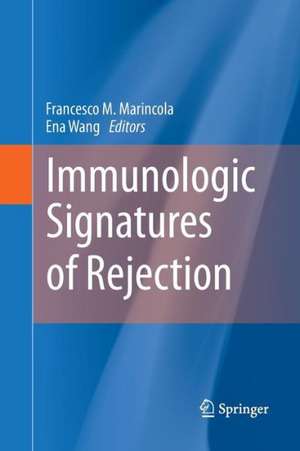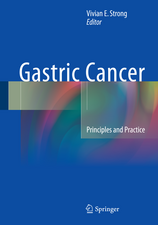Immunologic Signatures of Rejection
Editat de Francesco M. Marincola, Ena Wangen Limba Engleză Paperback – 9 oct 2014
| Toate formatele și edițiile | Preț | Express |
|---|---|---|
| Paperback (1) | 1097.91 lei 6-8 săpt. | |
| Springer – 9 oct 2014 | 1097.91 lei 6-8 săpt. | |
| Hardback (1) | 1103.03 lei 6-8 săpt. | |
| Springer – 2 noi 2010 | 1103.03 lei 6-8 săpt. |
Preț: 1097.91 lei
Preț vechi: 1155.69 lei
-5% Nou
Puncte Express: 1647
Preț estimativ în valută:
210.10€ • 218.11$ • 175.20£
210.10€ • 218.11$ • 175.20£
Carte tipărită la comandă
Livrare economică 22 martie-05 aprilie
Preluare comenzi: 021 569.72.76
Specificații
ISBN-13: 9781489982438
ISBN-10: 1489982434
Pagini: 364
Ilustrații: VII, 353 p.
Dimensiuni: 155 x 235 x 19 mm
Greutate: 0.51 kg
Ediția:2011
Editura: Springer
Colecția Springer
Locul publicării:New York, NY, United States
ISBN-10: 1489982434
Pagini: 364
Ilustrații: VII, 353 p.
Dimensiuni: 155 x 235 x 19 mm
Greutate: 0.51 kg
Ediția:2011
Editura: Springer
Colecția Springer
Locul publicării:New York, NY, United States
Public țintă
ResearchCuprins
Part One - From “delayed allergy reaction” to the “immunologic constant or rejection” 1. Ena Wang and Francesco M MarincolaPart Two - The immune biology of rejection; basic principles2. Experimental models of rejection – Anil Shanker A3. Cancer and Inflammation – Alberto Mantovani 4. The immunologic switch – Giorgio Trinchieri 5. The angiogenic switch – Douglas Noonan 6. Chemokines and cytotoxic effector molecules in rejection – Alan Krensky 7. Immune cell activation: the clinical perspective – David F Stroncek Part Three - Circulating patterns associated with chronic and acute immune pathology8. Immune signatures detectable in peripheral lymphocytes: a modular view – Damien Chaussabel 9. Immune signatures associated with unresolving compared to resolving infections: the HCV model – Robert E Lanford 10. Immune signatures associated with unresolving infections: the HIV model – Luigi Buonaguro11. Immune signatures associated with the cancer-bearing status – Peter P LeePart Four - Tissue-specific patterns associated with chronic inflammatory processes12. Signatures associated with destructive autoimmune pathologies – Steve Jacobson13. Predictors of favorable outcome in cancer – Zoltan Pos14. Other predictors of outcome - George Coukos 15. Transcriptional profiling of melanoma as a potential predictive biomarker for response to immunotherapy – Thomas F. Gajewski16. Predictors of allograft rejection - Sarwal MinniePart Five - Signatures associated with acute rejection17. Graft vs Host – Fran Hakim18. Tumor rejection– Ena Wang19. Allograft rejection – Davide Bedognetti
Textul de pe ultima copertă
This book collects salient observational data, derived predominantly from human studies, regarding the mechanism(s) of rejection in various pathologic conditions; the premise is that immune rejection, better defined as “immune-mediated, tissue-specific destruction” (TSD), comprises a broad range of phenomena ranging from tumor regression, to clearance of pathogen through destruction of infected cells, autoimmunity, allograft rejection by the host and host versus graft reactions. Like different hands can turn on or off a switch, distinct mechanisms can trigger TSD; however, a convergent pathway is ultimately observed when TSD occurs consisting of a dramatic switch from chronic to acute inflammation leading to the activation of a restricted number of genes that we comprise in the immunologic constant of rejection (ICR) model. Although the ICR model does not address “why” rejection occurs but rather “how”, and it may not contribute an explanation for the determinism of rejection, it provides, if correct, a simplified road map about the convergent pathways leading to TSD. This offers the opportunity to identify a common target for immune manipulation with therapeutic purposes since ICR-related pathways are restricted in expression to the tissues in which TSD occurs while are shut off in the rest of a normal organism.The book includes chapters from outstanding basic and/or observational scientists that have contributed to this area either by defining mechanisms relevant to the understanding of the inflammatory switch or by describing how this occurs in human tissues under different pathological conditions. We would like to entice our reader(s) to test with us, through, the readings, whether our hypothesis is correct; we predict that common themes will emerge particularly if attention will be paid to the general phenomenon of TSD rather than the peculiarities of individual pathologies. With the hope of having contributed with this book something novel and important and we wish our reader a pleasant journey in the wondrous land of immune-mediated, tissue-specific destruction.
Caracteristici
This book discusses the mechanisms leading to immune-mediated tissue rejection following the hypothesis that independent of the disease process the final effector mechanism is shared by most pathologies and it is relatively simple.
Several disease processes will be discussed including example of chronic inflammatory process without resolution of the pathologic process.
Several disease processes will be discussed including example of chronic inflammatory process without resolution of the pathologic process.











